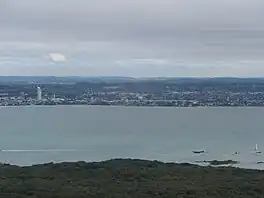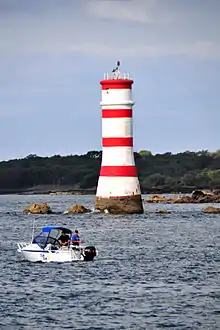Rangitoto Channel
The Rangitoto Channel is an area of the Hauraki Gulf in the Auckland Region of New Zealand's North Island. The channel is north-east of the Waitematā Harbour, and is located between the North Shore and Rangitoto Island. The channel's traditional Ngāi Tai name is Te Awanui o Peretū, and is an important deep water shipping channel to reach the Ports of Auckland.
| Rangitoto Channel | |
|---|---|
 The Rangitoto Channel, looking west towards the North Shore from Rangitoto Island. | |
 Rangitoto Channel Location within the Auckland Region | |
| Location | Auckland Region, New Zealand |
| Coordinates | 36.803°S 174.817°E |
| River sources | Wairau Creek |
| Ocean/sea sources | Hauraki Gulf, Pacific Ocean |
| Basin countries | New Zealand |
| Islands | Duder Spit, Rangitoto Island |
| Settlements | Belmont, Cheltenham, Hauraki, Milford, Narrow Neck, Takapuna, Vauxhall |
Geography
The Rangitoto Channel is located in Auckland, between the North Shore and Rangitoto Island.[1] During the Last Glacial Maximum (known locally as the Ōtira Glaciation), the area was a valley for the Waitematā River, which when sea levels rose between 12,000 and 7,000 years ago became the Waitematā Harbour.[2] The channel is an important stretch of water as it is the only deep water approach to Auckland Port for large ships such as container cargo ships and passenger cruise liners.[3]
History
The traditional Ngāi Tai name for the Rangitoto Channel is Te Awanui o Peretū or "The Great Channel of Peretū", named after an early ancestor in Tāmaki Makaurau, who lived at Narrow Neck and kept a kākā parrot reserve on Rangitoto Island.[4][5] The channel was visited by the Tainui migratory canoe after arriving in Tāmaki Makaurau.[6][7]
During the Russian scare of the 1880s, coastal fortifications were built along the Rangitoto Channel, including a fort at North Head and a military camp, Fort Cautley, at Narrow Neck. These were upgraded during World War II, and further gun emplacements were constructed at Castor Bay and other East Coast Bays areas to the north.[8]
The channel was last dredged from a depth of 11.2m to 12.5m in a two-stage process in 2004. The first stage involved the mechanical excavation of hard rock. Blasting was not required. This was followed by the removal of softer material. All dredged material was used in the reclamation at Fergusson wharf.[9][10]
Gallery
 The Rangitoto Lighthouse is located along the Rangitoto Channel
The Rangitoto Lighthouse is located along the Rangitoto Channel.jpg.webp) Satellite view of Rangitoto Channel
Satellite view of Rangitoto Channel.jpg.webp) View of Rangitoto Island from Milford Beach
View of Rangitoto Island from Milford Beach
References
- "Rangitoto Channel". New Zealand Gazetteer. Land Information New Zealand. Retrieved 29 June 2023.
- "Estuary origins". National Institute of Water and Atmospheric Research. Retrieved 3 November 2021.
- Land Information New Zealand Marine chart NZ532
- Ngāi Tai ki Tāmaki (April 2016). Cultural Values Assessment Report to New Zealand Transport Agency for Northern Corridor Improvements Project (NCI) (PDF) (Report). NZ Transport Agency. Retrieved 30 June 2023.
- Simmons, D. R. (1979). "George Graham's Maori Place Names of Auckland". Records of the Auckland Institute and Museum. 16: 11–39. ISSN 0067-0464. JSTOR 42906272. Wikidata Q58677091.
- Heritage Consultancy Services (1 July 2011). North Shore Heritage - Thematic Review Report Volume 1 (PDF) (Report). Auckland Council. ISBN 978-1-927169-21-6. Retrieved 29 June 2023.
- Willis, Jenny (2018). Early History of East Coast Bays (Second ed.). p. 6.
- Verran, David (2010). The North Shore: An Illustrated History. North Shore: Random House. p. 102-103, 111. ISBN 978-1-86979-312-8. OCLC 650320207. Wikidata Q120520385.
- Rock removed from shipping lane
- Rangitoto Shipping Lane Dredging & Wharf Reclamation